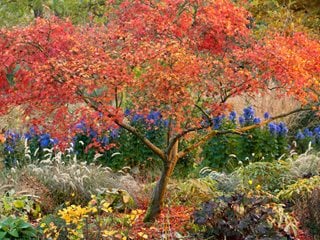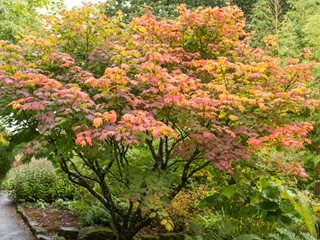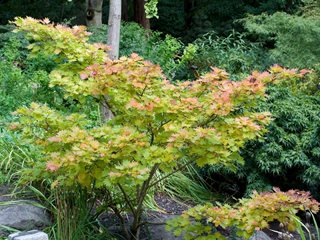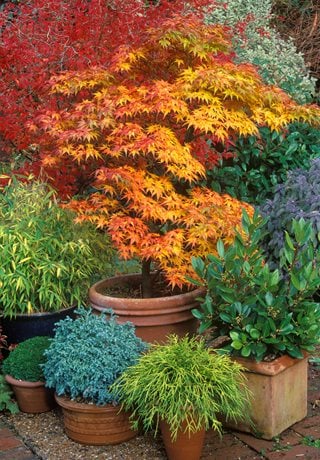Japanese Maple Types
Compare popular Japanese maple tree speciesWhen compared to the Japanese maple in size, form, leaf shape, and color, few other plants present so many options. The staggering diversity of Japanese maple varieties, has been remarkably generated primarily from just three species: Acer palmatum, Acer japonicum (native to Japan, Korea, and China), and Acer shirasawanum (native to Japan). Compare them below.
Learn how to grow & care for Japanese maple trees.
Zones:
5-8Height:
Varieties from 10 to 25 feetSpread:
Varieties from 10 to 25 feetExposure:
Full sun in northern zones, prefers afternoon shade in southern zones.Water:
MediumThe largest group of Japanese maples with many popular cultivars. These deciduous shrubs and small trees grow in rounded to broad-rounded form, commonly with low branching. Its leaves have 5-9 pointed, toothed lobes. Small flowers bloom in mid-spring which are attractive close up, but not particularly showy from a distance.
Zones:
5-7Height:
Dwarf varieties from 8 to 10 feet, standard varieties from 20 to 30 feetSpread:
Dwarf varieties from 8 to 10 feet, standard varieties from 20 to 30 feetExposure:
Full sun to part shadeWater:
MediumJaponicums have proven to be cold hardy and have beautiful fall color. Popular cultivars are ‘Aconitifolium’ and ‘Vitifolium’. Small flowers bloom in mid-spring which are attractive close up, but not particularly showy from a distance.
Zones:
5-7Height:
Varieties from 16 to 20 feetSpread:
Varieties from 16 to 20 feetExposure:
Full sun to part shadeWater:
MediumCommonly called full-moon maple or shirasawa maple, and similar in appearance to A. japonicum. A small-growing, upright, rounded deciduous tree that also grows as a multi-stemmed shrub that is primarily grown for its excellent fall color. Small flowers bloom in mid-spring which are attractive close up, but not particularly showy from a distance.
There are dwarfs, midsize, and large. Some varieties are vase shaped, while others form columns or gracefully cascade. Some leaves are star shaped or nearly round; some are deeply dissected and lacy. Other often overlooked features are their sculptural trunks and branching, tufts of colorful flowers, and clusters of winged seeds called samaras.
Japanese Maple Forms
Japanese maples come in many forms-some are airy and upright, while others are compact and domed. Here are the most common terms used to describe their forms.
- Vase: The branches of these trees grow up and out, for a tree that is narrow at the base, but wide at the top.
- Weeping: With pendulous branches that arch gracefully downward, weeping maples cascade in a similar fashion to a waterfall.
- Compact/dwarf: Growing to heights of just 3 to 6 feet, these types make an excellent choice for growing in a pot.
Japanese Maple Leaf Types
The leaves of Japanese maples can differ greatly between varieties, with some arranged in layers like roof shingles, some variegated along the margins or with webs of veining, and others that are curled, crinkled and clustered in tufts. Below are common terms used to describe Japanese maple leaves.
- Amoenum: Leaves are divided less than 2/3 of the way to the base.
- Palmate: Leaves are divided 2/3 to 3/4 of the way to the base.
- Matsumurae: Leaves are divided more than 3/4 of the way to the base.
- Dissectum: Leaves are deeply divided into lobes and sub-lobes; described as lacy, dainty or ferny.
- Linearilobum: Leaves are divided all the way to the base; described as strap-, ribbon-, or bamboo-like.



